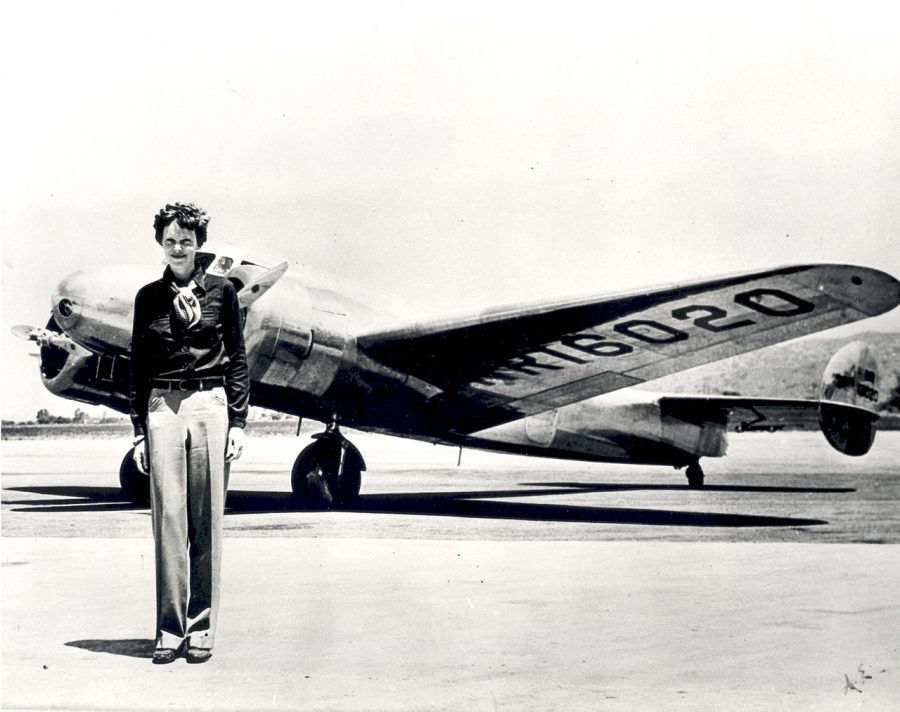New Theory for Earhart’s Disappearance Emerges
Earhart stands next to a Lockheed Electra, the plane that she and Noonan were in when they disappeared.
Everyone knows the story of Amelia Earhart, the most famous woman in aviation history. After becoming the first woman to fly solo across the Atlantic Ocean in 1932, she set her sights on circumnavigating the globe. She and her navigator, Frederick Noonan, had flown 22,000 miles before they took off from Lae, New Guinea at midnight on July 2, 1937. The plane never reached its intended destination, Howland Island. Earhart, Noonan, and their Lockheed Model 10 Electra plane vanished into the Pacific.
The “crash and sink” theory is the most widely accepted explanation for the legendary disappearance. Supposedly, the Electra ran out of fuel, crashed, and sank into the Pacific. Some say that Earhart and Noonan were captured and killed by the Japanese. Other theories include that Earhart was a top-secret spy for FDR, she worked for a Japanese propaganda program, she turned around mid-flight, she changed her name and moved to New Jersey or Guadalcanal, she eloped with Noonan, or even that she was abducted by aliens. These theories are pure speculation, and they may soon be put to rest as investigators grow closer to solving the 79-year-old mystery.
The International Group for Historic Aircraft Recovery, or TIGHAR, has been analyzing a partial skeleton found on Nikimaroro (formerly known as Gardner Island), Kiribati, since 1998. Anthropologists Karen Burns and Richard Jantz, along with forensic imaging specialist Jeff Glickman, found that the skeleton has remarkably long forearms. A photo of Earhart’s bare arms shows that she shared this characteristic. After comparing bone length ratios, they concluded that the skeleton may well have been Earhart’s. TIGHAR also recently revealed that between July 2 and July 6, 1937, Earhart radioed for help over 100 times. This means that the Electra could not have crashed and sunk immediately, because a running engine is necessary for radio use.
Those who dispute that the evidence points toward a new theory have argued that Earhart’s plane must have crashed in the Pacific and sunk because exhaustive search efforts could not locate it. However, it took rescue planes a full week to reach Nikimaroro. By the time they flew over the island, the current could have dragged the Electra out to sea. Others are skeptical because two people were on the Electra, and only one set of human remains was found on the island. However, Earhart reported that Noonan was injured in one of her transmissions, and TIGHAR speculates that his body was swept away with the aircraft. Earhart, on the other hand, could have lived on the island for months.
Ric Gillespie, the executive director of TIGHAR, has organized multiple expeditions to Nikimaroro. His team of experts found evidence of bonfires, animal bones, and a makeshift hut, showing that at least one human lived there for an extended period of time. When investigators flew over the island just after Earhart disappeared, they reported seeing “recent signs of life” even though the tiny island had not been inhabited since the 1800s.
Although major steps have been taken in the investigation, it is still impossible to be certain that Earhart and Noonan made it to Nikimaroro. After Earhart crashed and before TIGHAR arrived to investigate, many people visited the island, but only one of them found any evidence of habitation. Old photographs that supposedly show the plane are too blurry to be conclusive. Almost all the evidence relies heavily on TIGHAR’s research, which has not yet been reinforced by another source. Furthermore, there are other related questions to be answered. For example, there are still no compelling, well-backed theories as to why Earhart and Noonan didn’t make it to Howland Island in the first place.
Although the mystery of her disappearance is still unsolved, new discoveries and research indicate that it may not be long before Amelia Earhart’s story can be fully told.



